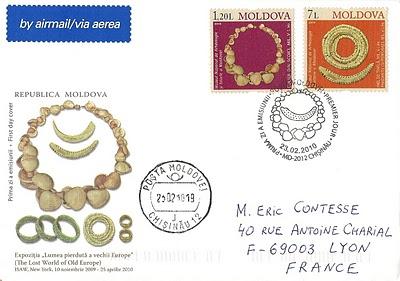Du 10 novembre 2009 au 25 avril 2010 est organisée à New York une exposition exceptionnelle consacré à des trésors archéologiques datant de 5000 à 3500 avant JC, témoins de la riche civilisation établie alors dans la vallée du Danube.
Cette exposition, organisée pour la 1ère fois aux États-Unis, a lieu à l'Institut pour l'étude du monde antique ("ISAW", "Institute for the Study of the Ancient World") rattaché à l'université de New York.
La poste moldave a eu la très bonne idée d'émettre, le 23 février 2010, une très jolie série de 2 timbres reproduisant des objets anciens, exposés à New York, et conservés au musée national d'histoire et d'archéologie de Chişinău, la capitale moldave.
Cette série figure sur le très réussi FDC officiel (tirage : 500 exemplaires...) ci-dessous avec l'enveloppe et l'oblitération "1er jour" reprenant les visuels des 2 timbres. Merci beaucoup Sergio :-)
From November 10, 2009 to April 25, 2010 is organized in New York a unique exhibition devoted to archaeological treasures dating from 5000 to 3500 BC that are masterpieces of the rich civilization then established in the Danube valley.
This exhibition, organized for the first time in the United States, is taking place at the Institute for the Study of the Ancient World ("ISAW"), at New York University.
The Post of Moldova had the excellent idea of issuing, on February 23, 2010, a very nice set of two stamps reproducing archaeological finds, on display in New York, and kept at the National Museum of History and Archeology in Chişinău, the Moldovan capital.
This series is included on the really successful official FDC (print run : 500 copies only...) below with the envelope and the FDC cancellation featuring the visuals of the two stamps. Thank you very much Sergio :-)
 Au 5ème millénaire avant JC, avant même l'invention de l'écriture et la fondation des premières villes en Mésopotamie et en Égypte, cette "vieille Europe" a été une des régions du monde les plus sophistiquées et technologiquement avancées, en particulier dans le sud-est de l'Europe lorsque des hommes se sont installés dans la fertile vallée du Danube.
Au 5ème millénaire avant JC, avant même l'invention de l'écriture et la fondation des premières villes en Mésopotamie et en Égypte, cette "vieille Europe" a été une des régions du monde les plus sophistiquées et technologiquement avancées, en particulier dans le sud-est de l'Europe lorsque des hommes se sont installés dans la fertile vallée du Danube.Trois pays ont hérité d'un patrimoine archéologique exceptionnel datant de cette période : la Roumanie, la Bulgarie et donc la Moldavie, toutes à l'honneur lors de cette exposition à travers des objets conservés dans 20 musées roumains, dans le musée régional d'histoire de Varna en Bulgarie et dans le musée national moldave d'histoire et d'archéologie.
Les 2 timbres moldaves ci-dessus représentent tous les deux des objets découverts dans les années 1990 lors de fouilles dans des tombes dans la région de Giurgiuleşti, témoins de la culture Suvorovo-Novodanilovka (groupe préhistorique nomade).
Un collier composé de 35 coquillages de la mer noire et 26 perles ainsi que des anneaux composés de perles en corail et un pendentif perforé créé à partir d'une défense de sanglier figurent sur ces timbres.
Cette émission aurait pu faire l'objet d'une très intéressante série commune avec les postes roumaines et bulgares !
In the 5th millennium BC, before the invention of writing and the founding of the first cities in Mesopotamia and Egypt, this "Old Europe" was then one of the world's most sophisticated and technologically advanced region, particularly in the south-eastern Europe where people settled in the fertile valley of the Danube river.
Three countries have inherited an exceptional archaeological heritage dating from this period : Romania, Bulgaria and Moldova, all honored at this exhibition through objects usually kept in 20 Museums from Romania, in the regional museum of History of Varna, Bulgaria and the National Museum of History and Archeology, Moldova.
The two Moldovan stamps above feature both finds discovered in the 1990's during excavations in graves located in the region of Giurgiuleşti, witnesses of the Suvorovo-Novodanilovka (a prehistoric nomadic group) culture.
A necklace comprised of 35 shells from the Black Sea and 26 beads, different circlets made of coral beads and also a boar tusk pendant with perforation are depicted on these stamps.
This issue could have been part of a very interesting joint set with the Romanian and Bulgarian postal administrations !

